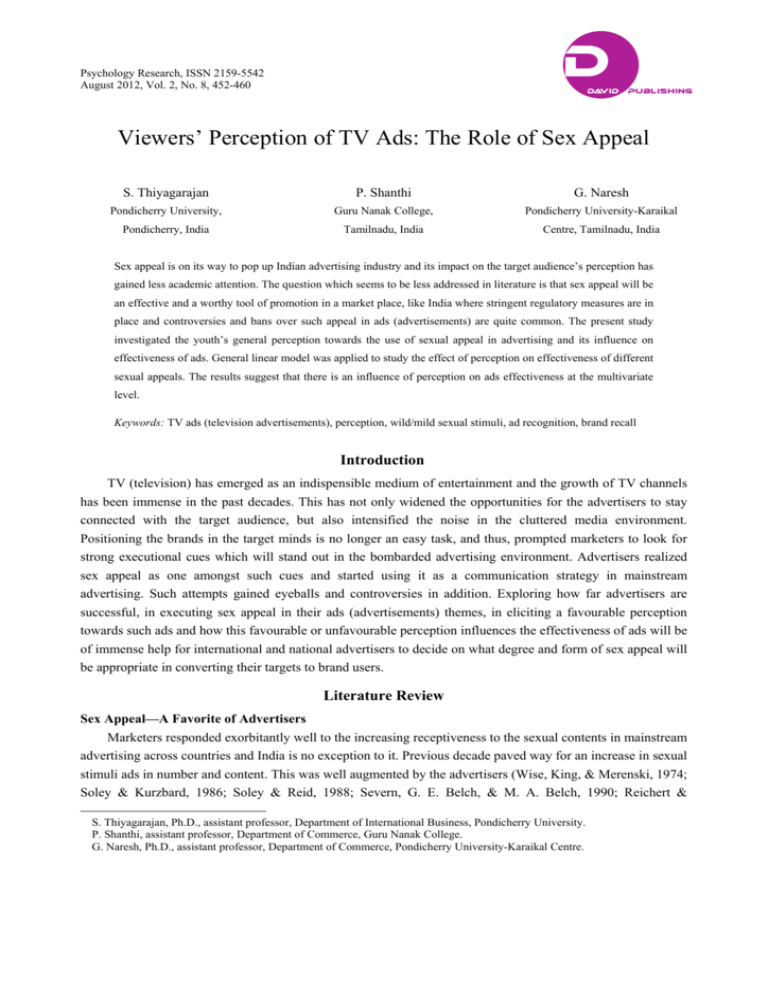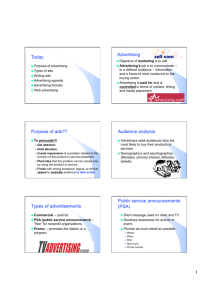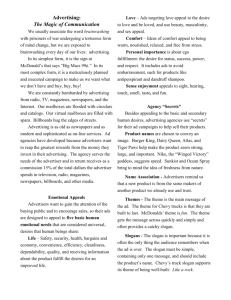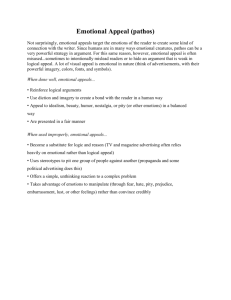
D
Psychology Research, ISSN 2159-5542
August 2012, Vol. 2, No. 8, 452-460
DAVID
PUBLISHING
Viewers’ Perception of TV Ads: The Role of Sex Appeal
S. Thiyagarajan
P. Shanthi
G. Naresh
Pondicherry University,
Guru Nanak College,
Pondicherry University-Karaikal
Pondicherry, India
Tamilnadu, India
Centre, Tamilnadu, India
Sex appeal is on its way to pop up Indian advertising industry and its impact on the target audience’s perception has
gained less academic attention. The question which seems to be less addressed in literature is that sex appeal will be
an effective and a worthy tool of promotion in a market place, like India where stringent regulatory measures are in
place and controversies and bans over such appeal in ads (advertisements) are quite common. The present study
investigated the youth’s general perception towards the use of sexual appeal in advertising and its influence on
effectiveness of ads. General linear model was applied to study the effect of perception on effectiveness of different
sexual appeals. The results suggest that there is an influence of perception on ads effectiveness at the multivariate
level.
Keywords: TV ads (television advertisements), perception, wild/mild sexual stimuli, ad recognition, brand recall
Introduction
TV (television) has emerged as an indispensible medium of entertainment and the growth of TV channels
has been immense in the past decades. This has not only widened the opportunities for the advertisers to stay
connected with the target audience, but also intensified the noise in the cluttered media environment.
Positioning the brands in the target minds is no longer an easy task, and thus, prompted marketers to look for
strong executional cues which will stand out in the bombarded advertising environment. Advertisers realized
sex appeal as one amongst such cues and started using it as a communication strategy in mainstream
advertising. Such attempts gained eyeballs and controversies in addition. Exploring how far advertisers are
successful, in executing sex appeal in their ads (advertisements) themes, in eliciting a favourable perception
towards such ads and how this favourable or unfavourable perception influences the effectiveness of ads will be
of immense help for international and national advertisers to decide on what degree and form of sex appeal will
be appropriate in converting their targets to brand users.
Literature Review
Sex Appeal—A Favorite of Advertisers
Marketers responded exorbitantly well to the increasing receptiveness to the sexual contents in mainstream
advertising across countries and India is no exception to it. Previous decade paved way for an increase in sexual
stimuli ads in number and content. This was well augmented by the advertisers (Wise, King, & Merenski, 1974;
Soley & Kurzbard, 1986; Soley & Reid, 1988; Severn, G. E. Belch, & M. A. Belch, 1990; Reichert &
S. Thiyagarajan, Ph.D., assistant professor, Department of International Business, Pondicherry University.
P. Shanthi, assistant professor, Department of Commerce, Guru Nanak College.
G. Naresh, Ph.D., assistant professor, Department of Commerce, Pondicherry University-Karaikal Centre.
VIEWERS’ PERCEPTION OF TV ADS: THE ROLE OF SEX APPEAL
453
Lambiase, 1999; Kilbourne, Painton, & Ridley, 1985). Researchers identified that suggestive behavior,
interaction, nudity, and factors, like setting and context, are some of the forms of sexual appeal. Sex appeal can
be defined as message in sense of brand information or an appeal in any context which is associated with sexual
information (Reichert, Heckler, & Jackson, 2001). Sex appeal is also defined as the amount of nudity or sexual
lucidity (Reichert, Heckler, & Jackson, 2001). Sex appeal is defined as sexual presentation of a product or
service with the sexual motives or the exploitation of the female or male body (Richmond & Hartman, 1982).
According to the study of Shimp (2003), using sexual components to increase attention, interest, involvement,
or recall of the message can be qualified as sexual appeal. Sexiness of clothing, amount of sexual imagery,
body language, wording, and amount of nudity, were perceived sexiness (Goodrich, 1999).
Studies on sexual appeal showed mixed result. Sex appeal is more engaging, involving, interesting,
entertaining, attention grabbing, favourable and original than non-sexual ads (Bello, Pitts, & Etzel, 1983;
Dudeley, 1999; Jude & Alexander, 1983; Severn et al., 1990; Reichert & Alvaro, 2001; Reichert, Heckler, &
Jackson, 2001). Sexual stimuli had led to increased attention and recognition which was validated with
empirical evidences by various researchers (Vezina & Paul, 1997; Chestnut, LaChance, & Lubitz, 1977; Reid
& Soley, 1981, 1983; De Pelsmacker & Geuens, 1998; Tissier-Desbordes & Manceau, 2002). There are equal
numbers of studies on negative effect of sexual appeal. Steadman (1969) found that sex appeal may act as
detractor deviating the viewer from brand which may result in lower brand recall and generate poorer product
and manufacturer’s perceptions, this effect is multiplied if the sexual explicitness is not matched well with
product advertised (Peterson & Kerin, 1977; Alexander & Judd, 1978; Grazer & Keesling, 1995; Judd &
Alexander, 1983; Reichert & Alvaro, 2001; Cui & Yang, 2009).
Is Sex Appeal Really Effective?
Advertisers often emphasize sexuality and the importance of physical attractiveness is an attempt to sell
products. Shimp (2003) clarified why sex appeal is often found to be a favorite attempt of the advertisers. Sex
appeal acts as an initial attention lure to the ad, which is referred as the stopping power of sex (Yovovich, 1983);
Next, it enhances the target audiences’ ability to recall the message advertised as sex is arousing, easy to relate,
emotion inducing, and most of all, memorable; Finally, sex appeal evokes emotional responses, such as feelings
of arousal, excitement, or even lust, which in turn can create stimulation and desire for the product (Bumler,
1999). Although it is believed that sex sells, it sells at the consequence of the controversy (Treise & Weigold,
1994). There is nothing wrong in the use of sexual ads, tastefully done, to sell some kinds of products (Treise &
Weigold, 1994). Indian consumers are more receptive and responsive to appeal which they can relate to their
senses (Anil, 2009).
Perception Towards Sex Appeal in Ads
Researchers showed that regardless of the period, people constantly are in the opinion that there is an
excessive use of sex appeal in ads (Wise, King, & Merenski, 1974; Treise & Weigold, 1994; Singh &Vij, 2007)
and it was females who had higher scores for the above agreement (Wise, King, & Merenski 1974). It was
found that females seem to find interaction between couples as sexual but physical description of the model is
sexual for males (Reichert & Ramirez, 2000). Asian countries seem to be more conservative than US (United
States) with respect to nudity in ads (Frith & Mueller, 2006), but contrary to this, Cheng, Liu, and Li (2009)
reported that Chinese consumers hold similar perception towards sex appeal ads as US consumers and even
more favourable perception than Australian consumers. Appropriate application of sexual appeal will stimulate
454
VIEWERS’ PERCEPTION OF TV ADS: THE ROLE OF SEX APPEAL
more positive ad execution related thoughts than non-sexual appeals (Reichert et al., 2001) and will influence
the effectiveness of ads (Shanthi & Thiyagarajan, 2012). Individuals not only prefer provocative sexual stimuli
in ads in general (Pope, Vogues, & Brown, 2004), but also exhibit more favourable responses and intention to
purchase (Grazer & keesling, 1995).
Negative reactions to sexual stimuli if it is not appropriate and in tasteful manner in ads have also been
reported by researchers. Peterson and Kerin (1977) found that seductive or decorative model was perceived
most favourably by all respondents, where as a nude model was perceived as least appealing, the product as the
lowest quality and the company as the least reputable. Steadman (1969) and Courtney and Whipple (1983)
warned that the use of overt sex appeal in advertising will be less effective than the non-sexual illustrations in
achieving brand and appeal evaluations as well as poor product and manufacturers’ perceptions. The use of
highly sexual theme in a print advertisement was not well received and was viewed as less ethically “correct”
than the use of a mild sexual version of the ad (LaTour & Henthrone, 1994). Further empirical evidence
emerged that unethically perceived ads have significantly potential negative effect on the consumers’ response
variables (Simpson, Horton, & Brown, 1996).
An Empirical Gap in Literature
Many researchers have contributed much on this topic yet little agreement has been reached concerning
the appropriateness and effectiveness of sex appeal used in ads. The lack of consensus creates space for
researchers to explore the effect of sex appeals in ads. Even though enormous studies have interrogated the
effect of sex appeal on ad effectiveness, all such studies have carried out either exploring gender difference in
responses to different degrees of sex appeal (Belch et al., 1981; Jude & Alexander, 1983; LaTour & Henthrone,
1994; Peterson & Kerin, 1977; Sciglimpaglia, Belch, & Cain, 1979; Simpson, Horton, & Brown, 1996; Jones,
Stanaland, & Gelb, 1998; Orth & Holancova, 2004; Jeong & Hwang, 2005; Sengupta & Dahl, 2008) or under
conditions like low/high involvement, low/high need for cognitions (Severn et al., 1990; Putrevu, 2008), and
low/high arousal (LaTour, Pitts, & Snook-Luther, 1990). Prior studies have explored perception as a response
dependent variable and sex appeal in ad stimuli as independent variable. Not much research work has been
reported about influence of perception on effect of sex appeal TV ads in Indian context. The current study tries
to fill in the gap by studying the influence of perception towards the use of sex appeal in TV ads on ad
effectiveness with reference to India.
Objectives of the Study
The objectives of this study are:
(1) To study the viewers’ perception on use of sex appeal in TV ads;
(2) To find out the effectiveness of sex appeal in TV commercials among the respondents (using ad
recognition and brand recall measures);
(3) To explore the influence of perception on the effect of sex appeal (wild/mild) ads both at univariate
and multivariate levels.
Methodology
After reviewing the previous research studies, it was found that most of the effectiveness studies on sex
appeal have opted for stimuli containing the print image of sexy female or male model fully clothed, partially
clothed, or nude. Only few researchers (Fisher & Byrne, 1978; Rubinsky, Eckerman, Rubinsky, & Hoover,
VIEWERS’ PERCEPTION OF TV ADS: THE ROLE OF SEX APPEAL
455
1987; Severn et al., 1990; Smith, Haugtvedt, Jadrich, & Anton, 1995; Reichert, Heckler, & Jackson, 2001;
Thiyagarajan & Shanthi, 2012) have taken couple images as an experimental instrument. Literature shows that
there is a significant amount of research studies conducted on the effect of sex appeal, most of which are the
Western studies, few studies conducted in China and Korea. Not many prior studies have looked at the
influence of perception towards the use of sexual appeal in ads in general on ad effectiveness incorporating TV
commercials showing sexy females (partially clothed/mild sex appeal and less clothed/wild sex appeal) as
stimuli particularly in Indian context. Hence, generalizing the results of previous studies to India would make
less or no sense. So this study attempted to look at the influence of perception towards the use of sexual appeal
in ads in general on ad effectiveness incorporating sexy female models in varying degree of clothing as stimuli
to fill up the gap found in literature.
Perception, Effectiveness, Recognition, and Recall Tests
Perception towards usage of sex appeal in ads was measured on a 5-point Likert scale using statements
relating to attractiveness, acceptance level, reachability, receptiveness, and persuasion (impulsive/boycott
brands) of sex appeal.
Advertising effectiveness is a degree to which an ad achieves its much needed objective of reaching the
eyeballs and catching the targeted minds. Hence, this study adopted ad recognition and ad (brand) recall tests to
quantify effectiveness of an ad. Ad recognition and ad (brand) recall tests measures were employed not merely
because these measures are used widely in ad appeal studies but are also accepted as most reliable metrics
(Steadman, 1969; Chestnut et al., 1977; Reid & Soley, 1981; Richmond & Hartman, 1982; Courtney &
Whipple, 1983; Tinkham & Reid, 1988; Severn et al., 1990; Thiyagarajan & Shanthi, 2011; Shanthi &
Thiyagarajan, 2012). To conduct the recognition test, participants were shown an ad and were asked whether
he/she remember seeing it and can remember any of its salient points and as part of recall test, the participants
were asked to recall the ad or brand name.
Selection of Ad Stimuli
Unlike previous studies where selection of sexual stimuli is purely a judgment and discretion of the
researchers, this study chose ads at random. As the first step in selection of ads, all the sexual appeal
commercials aired in popular channels, for a 4-week period (December, 2010), were pooled. These pooled ads
were later shown to a small group of 30 respondents and were asked to rate these ads, on a 5-point scale, on the
basis of the amount of clothing of a model. All ads with mean score of three and above were grouped as wild
appeal and the ones with a mean score of below three were grouped as mild appeal. One ad was selected at
random from each cluster or group and these were the two ads used for the final study.
Method of Data Collection
Data were collected form 350 respondents in and around Chennai City by employing a non-probability
sampling method. But the final sample for the study was 280 comprising of 140 males and equal number of
females in the age group of 18 to 35 residing in Chennai and its suburbs. A structured interview schedule was
the instrument used for data collection. The respondents were met at their homes and college classrooms (after
college hours with the permission of the faculties) to create the much needed privacy mainly to ease true
response. In the first half an hour’s session, the respondents were asked to reveal their general perception
towards sexual appeal in ads. Perception was measured on a 5-point scale which had a reliability of 0.793. In
the next 20 minutes, the selected ads’ (two in number) brands were concealed and were played with a help of
456
VIEWERS’ PERCEPTION OF TV ADS: THE ROLE OF SEX APPEAL
laptop to the respondents after which they were asked to recognize the ads and recall the ads with the brand.
Based on these test results effectiveness scores were derived. MANOVA (multivariate analysis of variance)
was used to see the influence of perception on different sexual stimuli ads. In a day, an average customer is
exposed to many types and levels of ad stimuli that is why this methodology was adopted for the study.
Findings and Discussion
From Table 1, it can be seen that 60.7% of the respondents have a favourable perception towards sexual
stimuli ads in TVs. Advertisers can take this as a positive sign as majority of the young respondents are liberals
towards these types of ads, there will be less resistance for sex appeal ads and advertisers can effectively use
sexual stimuli to promote their products.
Table 1
Perception Towards Sexual Appeal in TV Commercials
Perceptional group
Favourable
Not so favourable
Total
Frequency
160
110
280
Percentage (%)
60.7
39.3
100
Table 2 is about the effectiveness of wild and mild sexual appeal stimuli ads. It can be seen from Table 2 that
wild sexual appeal ads are effective among 49.64% of the respondents while mild sex appeal ad is effective
among an overwhelming 73.21% of the respondents signaling that mild appeal ads reach better than the wild
ones.
Table 2
Effectiveness of Sexual Appeal TV Commercials
Effectiveness
Effective
Not so effective
Total
Bold
Frequency
147
133
280
Percentage (%)
49.64
50.36
100
Frequency
205
75
280
Mild
Percentage (%)
73.21
26.79
100
Null hypothesis (Ho): There is no influence of perception on effectiveness of sex appeal ads.
General linear model was applied to study the effect of perception on effectiveness of different sexual
appeal. From Table 3, it can be said, by looking at the intercept, that the mean effectiveness of the sex appeal
ad is different from zero, because the significance for all the tests is less than 0.05, indicating a variation in
effectiveness in the population. By looking at the perception and its significance for all the tests which is less
than 0.05, null hypothesis (Ho is rejected. From this, it can be concluded that there is an influence of perception
on effectiveness at the multivariate level. All these results indicate that effectiveness of the sex appeal
(regardless of the degree of sex appeal) as a message strategy primarily depends upon the perception of the
viewers. If the viewers are liberal and have an open mind towards sex appeal ads, these ads can be more
effective and successful. Furthermore, when looking at the univariate level, perception has an influence on wild
sex appeal but not on mild sex appeal (see Table 4). This is throwing up an interesting message to the
advertisers those want to use wild sex appeal in their message strategy to rethink about such attempt as it may
elicit positive responses among the group who have a favorable perception towards sex appeal ads but the same
457
VIEWERS’ PERCEPTION OF TV ADS: THE ROLE OF SEX APPEAL
might be counterproductive among unfavorable group. Hence, to play safe is always better to design the ads
strategies with mild sexual stimuli where the risk and uncertainty are relatively less. This is evident from the
difference in the mean scores for mild appeal which is less between the different perceptional groups.
Table 3
Effect of Perception on Sexual Appeals
Sexual appeal
Bold
Mild
Perception
Mean
Not so favourable
1.15
Favourable
1.98
Total
1.61
Not so favourable
2.38
Favourable
2.28
Total
2.32
Effect
Intercept
Perception
Value
F
Sig.
Pillai’s trace
0.830
675.913
0.000
Wilks’ lambda
0.170
675.913
0.000
Hotelling’s trace
4.880
675.913
0.000
Roy’s largest root
4.880
675.913
0.000
Pillai’s trace
0.086
13.085
0.000
Wilks’ lambda
0.914
13.085
0.000
Hotelling’s trace
0.094
13.085
0.000
Roy’s largest root
0.094
13.085
0.000
Table 4
Tests of Between-Subjects Effects (Individual Effect)
Source
Dependent variable Type III sum of squares
Bold
48.238
Corrected model
Mild
0.739
Bold
675.067
Intercept
Mild
1,496.810
Bold
48.238
Perception
Mild
0.739
Bold
546.329
Error
Mild
366.333
Bold
1,321.000
Total
Mild
1,876.000
Bold
594.568
Corrected total
Mild
367.071
a. R2 = 0.081 (Adjusted R2 = 0.078)
b. R2 = 0.002 (Adjusted R2 = -0.002)
df
1
1
1
1
1
1
278
278
280
280
279
279
Mean square
48.238
0.739
675.067
1,496.810
48.238
0.739
1.965
1.318
F
24.546
0.560
343.508
1,135.888
24.546
0.560
Sig.
0.000
0.455
0.000
0.000
0.000
0.455
Conclusions
Indian society is multifaceted, though it is undergoing significant socio-economic changes; it largely
remains a conservative society. Youth has been observed as trendsetters, early adopters, literate, more positive,
idealistic, and multicultural, and usually care for practical ads that sell a life style instead of just a product
(Macieijewski, 2004). Reality also echoes the same as youngster are seem to be an adult of mixed properties
like dynamism, vulnerability, idealism, and fun-seeking. Catching the eyeballs and minds of this particular
segment is not the easy task. Responsibility of the advertisers goes beyond designing an ad campaign in
country like India where conservative mentality and liberal perception prevail simultaneously. Actually, the
challenge lies not only in how effectively the advertisers are constructing the commercials with vibrant wild
sexual stimuli, but also in how convincingly it has been executed among various target groups with
458
VIEWERS’ PERCEPTION OF TV ADS: THE ROLE OF SEX APPEAL
perceptional differences. To conclude, sex appeal ads could be effective in communicating and in reaching the
audience’s subject to its conformity to the perception of the target viewers.
References
Alexander, M. W., & Judd, B. B. (1978). Do nudes in ads enhance brand recalls? Journal of Advertising Research, 18(1), 47-50.
Anil, M. (2009). Indian perspective about advertising appeal. International Journal of Marketing Studies, 1(2), 23-34.
Aruna, K. N., & Sahni, S. (2008). Perception of adolescents regarding portrayal of women in commercial advertisements in TV.
Journal of Social Sciences, 17(2), 121-126.
Belch, M. A., Holgerson, B. E., Belch, G. E., & Koppman, J. (1981). Psychophysiological and cognitive responses to sex in
advertising. In M. Andrew (Ed.). Advances in consumer research (Vol. 9, pp. 424-427). Ann Arbor, M. I. : Association for
Consumer Research.
Bello, D. C., Pitts, R. W., & Etzel, M. J. (1983). The communication effects of controversial sexual content in television programs
and commercials. Journal of Advertising, 12(3), 32-42.
Bumler, J. (1999). Sex appeal in advertising. Retrieved April 15, 2004, from http://www.people.virginia.edu/jab4bx/assignments
/PaperIII.html
Cheng, H., Liu, F., & Li, J. (2009). Consumer responses to sex appeal advertising: A cross-cultural study. International Marketing
Review, 26(4), 501-520. doi: 10.1108/02651330910972002
Chestnut, R. W., LaChance, C. C., & Lubitz, A. (1977). The “decorative” female model: Sexual stimuli and the recognition of
advertisements. Journal of Advertising, 6, 11-14.
Courtney, A. E., & Whipple, T. W. (1983). Sex stereotyping in advertising. Lexington, M. A.: D. C. Heath and Co..
Cui, G., & Yang, X. (2009). Responses of Chinese consumers to sex appeals in international advertising: A test of congruency
theory. Journal of Global Marketing, 22(3), 29-245.
De Pelsmacker, P., & Geuens, M. (1998). Reactions to different types of ads in Belgium and Poland. International Marketing
Review, 15(4), 277-290.
Dudley, S. C. (1999). Consumer attitudes towards nudity in advertisements. Journal of Marketing Theory and Practice, 79(4),
89-96.
Fisher, W. A., & Byrne, D. (1978). Sex differences in response to erotica? Love versus lust. Journal of Personality and Social
Psychology, 36(1), 117-125.
Frith, K., & Mueller, B. (2006). Advertising and gender representation. In K. Frith, & B. Muller (Eds.), Advertising and societies:
Global issues (pp. 91-96). New York: Peter Lang.
Goodrich, S. (1999). What is sexy? Correlates from a study of recent magazine advertisements. (Doctoral dissertation, Graduate
Faculty of Texas Tech University). Retrieved from http://repositories.tdl.org/ttu-ir/bitstream/handle/2346/18372/3129501489
3043.pdf?sequence=1
Grazer, W. F., & Keesling, G. (1995). The effect of print advertising’s use of sexual themes on brand recall and purchase intention:
A product specific investigation of male responses. Journal of Applied Business Research, 11(3), 47-58.
Groza, N., & Cuesta, J. F. (2011). Sexist humor in advertising: Just a joke or marketing strategy? International Journal of Arts
and Technology, 4(1), 61-73.
Jeong, S., & Hwang, Y. (2005). Persuasive effects of nudity in print advertising: The moderating role of viewer gender and degree
of nudity. Paper presented at the Annual Meeting of the International Communication Association, Sheraton, New York.
Retrieved from http://www.allacademic.com/meta/p13246_index.html
Jones, M. Y., Stanaland, A., & Gelb, B. D. (1998). Beefcake and cheesecake: Insight for advertisers. Journal of Advertising, 27(2),
33-51.
Judd, B. B., & Alexander, M. W. (1983). On the reduced effectiveness of some sexually suggestive advertisement. Journal of the
Academy of Marketing Science, 11(2), 156-168.
Kilbourne, W. E., Painton, S., & Ridley, D. (1985). The effect of sexual embedding on responses to magazine advertisements.
Journal of Advertising, 14(2), 48-56.
LaTour, M. S., & Henthorne, T. L. (1994). Ethical judgments of sexual appeal in print advertising. Journal of Advertising, 23(3),
81-90.
LaTour, M. S., Pitts, R. E., & Snook-Luther, D. C. (1990). Female nudity, arousal and ad response: An experimental investigation.
Journal of Advertising, 19, 51-62.
VIEWERS’ PERCEPTION OF TV ADS: THE ROLE OF SEX APPEAL
459
Macieijewski, J. J. (2004). Is the use of sexual and fear appeals ethical? A moral evaluation by generation Y college students.
Journal of Current Issues and Research in Advertising, 26, 97-105.
Malhotra, S., & Rogers, N. (2001). Changing female images revolution. In A. Singhal, & E. M. Rogers (Eds.), India’s
communication revolution: From bullock carts to cyber marts (p. 124). New Delhi: Sage.
Orth, U. R., & Holancova, D. (2004). Men’s and women’s responses to sex role portrayals in advertisements. International
Journal of Research in Marketing, 21, 77-88.
Peterson, R. A., & Kerin, R. A. (1977). The female role in advertisements: Some experimental evidence. Journal of Marketing,
41(4), 59-63.
Pope, N. K. L., Vogues, K. E., & Brown, M. R. (2004). The effect of provocation in the form of mild erotica on attitude to the ad
and corporate image: Difference between cause-related advertising and consumer product advertising. Journal of Advertising,
33(1), 69-82.
Putrevu, S. (2008). Consumer responses toward sexual and nonsexual appeals: The influence of involvement, need for cognition
and gender. Journal of Advertising, 37(2), 57-69.
Reichert, T., & Alvaro, E. (2001). The effect of sexual information on ad and brand processing and recall. Southwestern Mass
Communication Journal, 17(1), 9-17.
Reichert, T., & Lambiase, J. (1999). Beef cake or cheese cake? No matter how you slice it sexual explicitness in advertising
continues. Journalism and Mass Communication Quarterly, 76, 7-20.
Reichert, T., & Ramirez, A. (2000). Defining sexually oriented appeals in advertising: A grounded theory investigation. Advances
in Consumer Research, 27(1), 267-273.
Reichert, T., Heckler, S. E., & Jackson, S. (2001). The effects of sexual social marketing appeals on cognitive processing and
persuasion. Journal of Advertising, 30(1), 13-27.
Reid, L. N., & Soley, L. C. (1981). Another look at the “decorative” female model: The Recognition of the visual and verbal ad
components. In J. H. Leigh, & C. R. Martin, Jr. (Eds.), Current issues in research and advertising (pp. 122-133). Ann Arbor,
M. I.: University of Michigan.
Reid, L. N., & Soley, L. C. (1983). Decorative models and the relationship of magazine ads. Journal of Advertising Research,
23(2), 27-32.
Richmond, D., & Hartman, T. P. (1982). Sex appeal in advertising. Journal of Advertising Research, 22(5), 53-61.
Rubinsky, H. J., Eckerman, D. A., Rubinsky, E. W., & Hoover, C. R. (1987). Early-phase physiological response patterns to
psychosexual stimuli: Comparison of male and female patterns. Archives of Sexual Behavior, 16(1), 45-56. doi:
10.1007/BF01541841
Sciglimpaglia, D., Belch, M. A., & Cain, R. F. (1979). Demographic and cognitive factors influencing viewers evaluations of sexy
advertisements. Advances in Consumer Research, 6, 62-66.
Sengupta, J., & Dahl, D. (2008). Gender related reactions to gratuitous sex appeal in advertising. Journal of Consumer Psychology,
18, 62-78.
Severn, J., Belch, G. E., & Belch, M. A. (1990). The effects of sexual and non-sexual advertising appeals and information level on
cognitive processing and communication effectiveness. Journal of Advertising, 19(1), 14-22.
Shanthi, P., & Thiyagarajan, S. (2012). Impact of viewer’s perception on effectiveness of couple image sex appeal advertisements.
European Journal of Business and Management, 4(1), 11-21. Retrieved from http://www.iiste.org/Journals/index.php/EJBM
/article/view/1022/942
Shimp, T. A. (2003). Advertising, promotion & supplemental aspects of integrated marketing communications (6th ed.). USA:
Thomson—South Western.
Simpson, P., Horton, S., & Brown, G. (1996). Male nudity in advertisements: A modified replication and extention of gender and
product effects. Journal of the Academy of Marketing Sciences, 24, 257-262.
Singh, R., & Vij, S. (2007, April). Socio-economic and ethical implications of advertising—A perceptual study. International
Marketing Conference on Marketing and Society, April 8-10, 2007, IIMK.
Smith, S. M., Haugtvedt, C. P., Jadrich, J. M., & Anton, M. R. (1995). Understanding responses to sex appeals in advertising: An
individual difference approach. In F. Kardes, & M. Sujan (Eds.), Advances in consumer research (Vol. 22, pp. 735-739).
Ann Arbor, M. I.: Association for Consumer Research.
Soley, L., & Kurzbard, G. (1986). Sex in advertising: Comparison of 1964 and 1984 magazine advertisements. Journal of
Advertising, 15(3), 46-54, 64.
460
VIEWERS’ PERCEPTION OF TV ADS: THE ROLE OF SEX APPEAL
Soley, L., & Reid, L. (1988). Taking it off: Are models in magazine ads wearing less? Journalism and Mass Communication
Quarterly, 65, 105-110, 131.
Steadman, M. (1969). How sexy illustration affect brand recall? Journal of Advertising, 9(1), 15-19.
Tai, S. H. C. (1999). Advertising ethics: The use of sexual appeal in Chinese advertising. Teaching Business Ethics, 3(1), 87-100.
Thiyagarajan, S., & Shanthi, P. (2011). Effect of couple image sexual stimuli in advertisements. SELP Journal of Social Science,
3(9), 57-59.
Tinkham, S. F., & Reid, L. N. (1988). Sex appeal in advertising revisited: Validation of a typology. In J. D. Leckenby (Ed.),
Proceedings of the 1988 Conference of American Academy of Advertising. Austin, T. X.: American Academy of Advertising,
118-123.
Tinkham, S. F., & Weaver-Lariscy, R. A. (1994). Ethical judgment of political television commercials as predictors of attitude
toward the ad. Journal of Advertising, 13(3), 43-58.
Tissier-Desbordes, E., & Manceau, D. (2002). Female nudity in advertising: What do French women think. In P. Maclaren, & E.
Tissier-Desbordes (Eds.), Proceedings of the 6th Conference on Gender, Marketing and Consumer Behaviour (pp. 85-104),
Association for Consumer Research, June 27-29, Dublin.
Treise, D., & Weigold, M. F. (1994). Ethics in advertising: Ideological correlates of consumer perceptions. Journal of Advertising,
23(3), 59-69.
Vezina, R., & Paul, O. (1997). Provocation in advertising: A conceptualization and an empirical assessment. International Journal
of Research in Marketing, 14, 177-192.
Weller, R. B., Roberts, C. B., & Newhaus, C. (1979). A longitudinal study of the effect of erotic content upon advertising brand
recall. Current Issues and Researches in Advertising, 1, 145-162.
Wise, G. L., King, A. L., & Merenski, P. J. (1974). Reaction to sexy ads vary with age. Journal of Advertising, 14(4), 11-16.
Yovovich, B. G. (1983). Sex in advertising: The power and the perils. Advertising Age, 54(19), 12-15.








